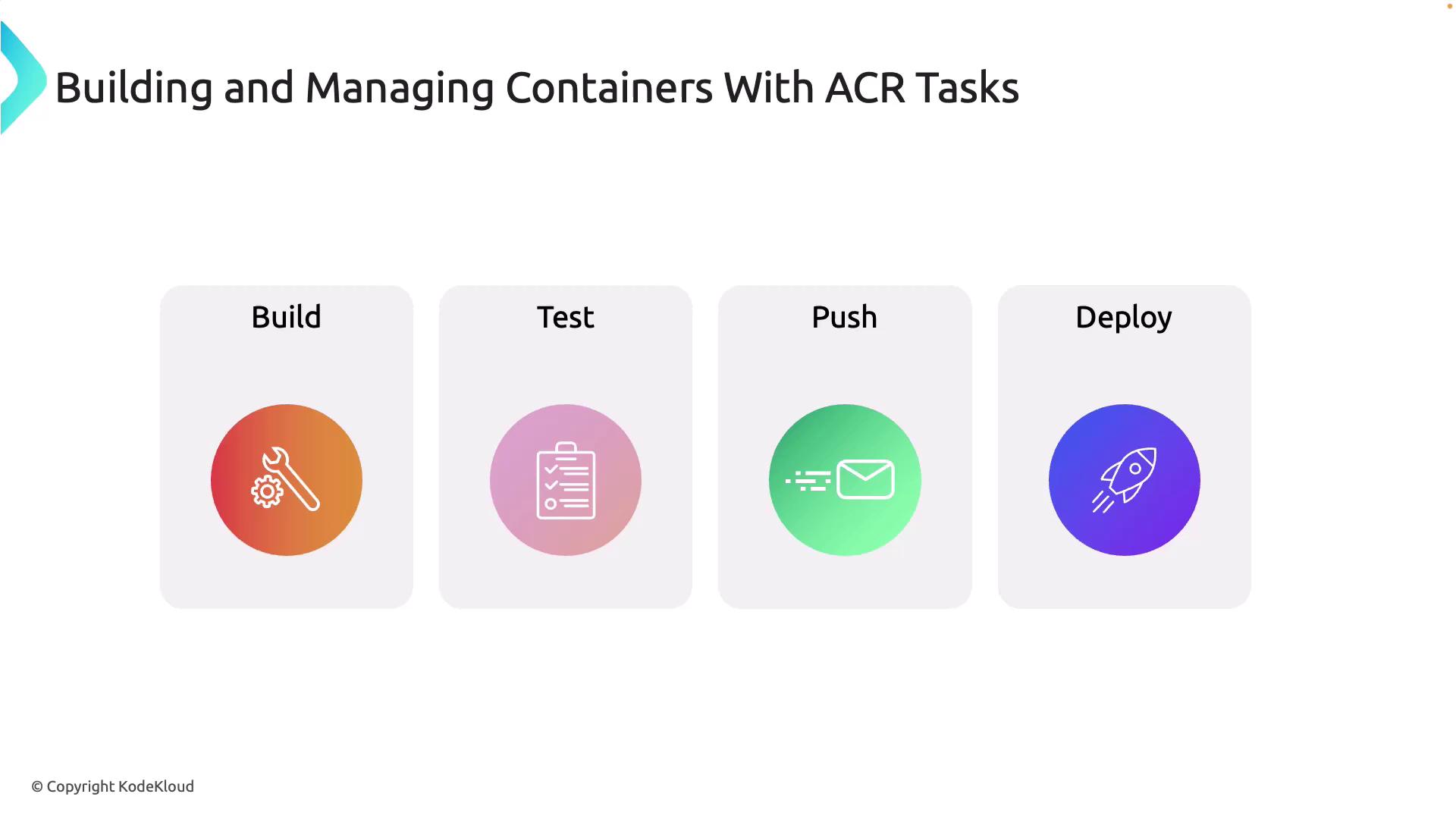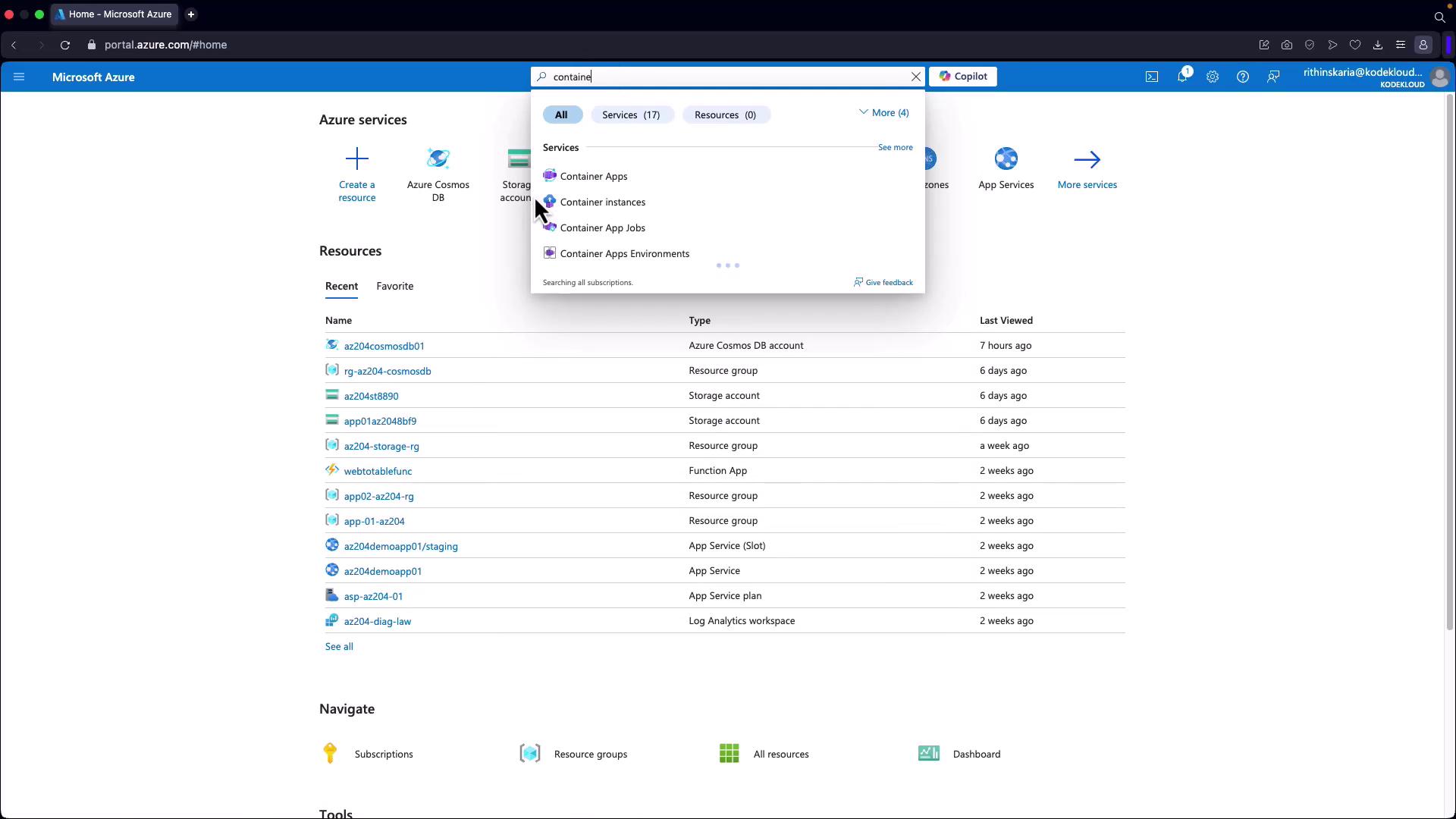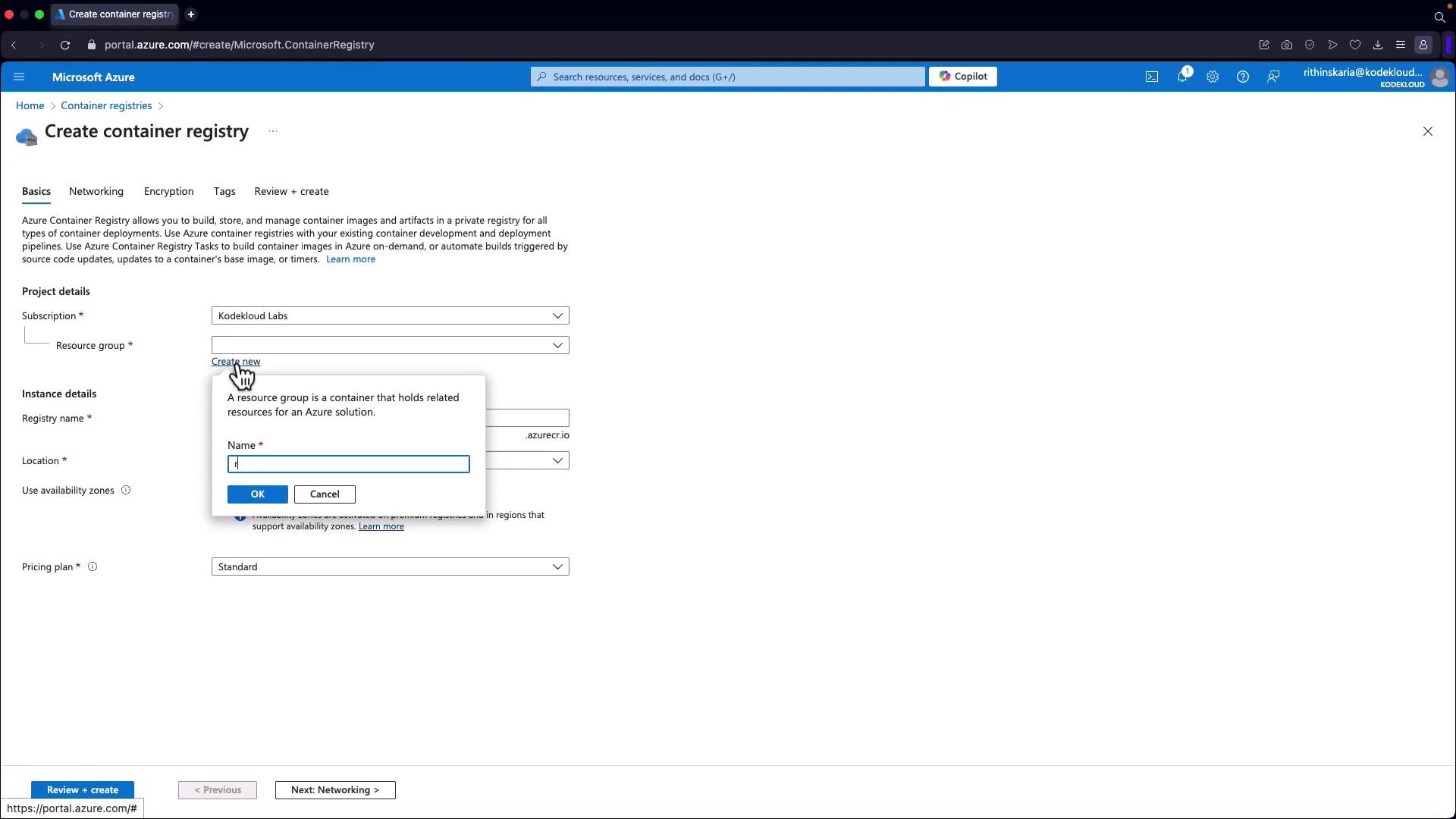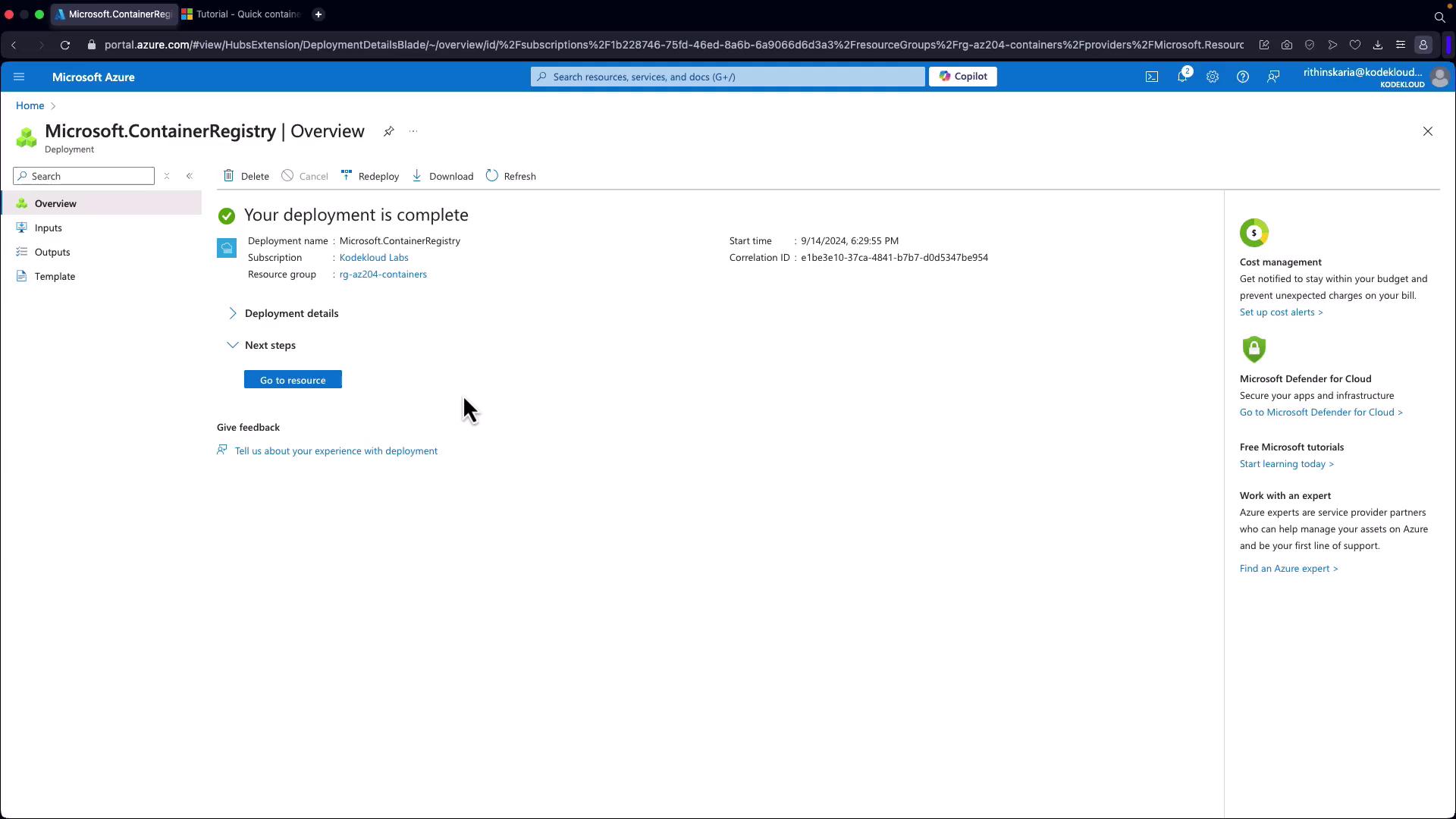AZ-204: Developing Solutions for Microsoft Azure
Managing Container Images in Azure Container Registry
Building and Managing Containers With ACR Tasks
In this article, we explore the key phases of building and managing containers using Azure Container Registry (ACR) Tasks. ACR Tasks allow you to automate the entire container lifecycle—from building and testing to pushing and deploying container images—thereby streamlining your development and CI/CD workflows.
Overview of the Container Lifecycle
Container lifecycle operations generally follow these steps:
- Build: Package your application and its dependencies into a Docker image. A Dockerfile defines the build process, and ACR Tasks help automate this step to ensure consistency and efficiency.
- Test: Integrate automated testing within ACR Tasks to validate the container image before deployment.
- Push: After successful testing, push the validated image to ACR, making it accessible in a centralized registry across development, staging, and production environments.
- Deploy: Deploy the containerized application to a live environment. ACR integrates seamlessly with Azure services such as Azure Kubernetes Service (AKS), Azure Container Instances (ACI), Azure Container Apps, and Azure App Service.

ACR Tasks essentially function as a continuous integration and continuous deployment (CI/CD) pipeline for container images, significantly reducing manual intervention.
Task Scenarios with ACR Tasks
ACR Tasks are flexible and support different workflows. Here are some common task scenarios:
Kube-Task
A kube-task is ideal for one-time builds or immediate tasks. It allows you to build a container image without setting up a complex CI/CD pipeline—perfect for rapid development or prototyping.
Automatically Triggered Tasks
Automatically triggered tasks execute based on specific events. For example, you can configure a trigger to start a new build whenever changes are detected in your source code repository. This integration with tools like Azure Pipelines ensures your container images remain up to date.
Multi-Step Tasks
Multi-step tasks enable you to design a comprehensive pipeline that includes additional steps such as testing or security scanning. By specifying a sequence of actions for your container image before it is pushed or deployed, you gain greater flexibility and control over your container management strategy.
![]()
Creating and Deploying a Container Image with ACR Tasks
This section demonstrates how to build a container image using a Dockerfile and then push that image to the Azure Container Registry.
Step 1: Create the Azure Container Registry
Log into the Azure Portal and search for "Container Registry" in the search box.

Click Create.
Create a new resource group (e.g.,
azr-az204-containers).
Provide a unique name for your registry (e.g.,
azr-az204). If the name is already taken, consider modifying it (for example, appending "KodeKloud" to ensure uniqueness).
Select your preferred location (e.g., East US) and choose the Standard tier. Note that networking options such as private access are limited to the Premium plan.
Click Review and Create to deploy the registry.
Once deployment is complete, the Azure portal will confirm the registry creation.

Step 2: Build Your Container Image Locally Using Cloud Shell
For this demonstration, we will use the Azure Cloud Shell. You can also perform these steps locally if preferred.
- First, verify that the necessary .NET runtimes are installed:
rithin [~] $ dotnet --list-runtimes
Microsoft.AspNetCore.App 8.0.0 [/usr/share/dotnet/shared/Microsoft.AspNetCore.App]
Microsoft.NETCore.App 8.0.0 [/usr/share/dotnet/shared/Microsoft.NETCore.App]
- Create a directory for your application and navigate into it:
rithin [~] $ mkdir App
rithin [~] $ cd App
- Generate a new ASP.NET Core web application:
rithin [~/App] $ dotnet new webapp -n MyWebApp
- Navigate to the application's Pages directory to verify the landing page:
rithin [~/App/MyWebApp] $ cd Pages
rithin [~/App/MyWebApp/Pages] $ ls
Error.cshtml Error.cshtml.cs Index.cshtml Privacy.cshtml Shared _ViewImports.cshtml _ViewStart.cshtml
- Display the content of the landing page:
rithin [~/App/MyWebApp/Pages] $ cat Index.cshtml
@page
@model IndexModel
<h1 class="display-4">Welcome</h1>
<p>Learn about <a href="https://learn.microsoft.com/aspnet/core">building Web apps with ASP.NET Core</a>.</p>
- If you wish to edit the page, use an editor like nano, then return to the parent directory:
rithin [~/App/MyWebApp/Pages] $ nano Index.cshtml
- Change back to the project root and create a Dockerfile:
rithin [~/App/MyWebApp] $ cd ../..
rithin [~/App] $ nano Dockerfile
- Paste the following content into your Dockerfile, which uses .NET 8.0:
# Dockerfile
# Step 1: Use the official ASP.NET Core 8.0 runtime as the base image
FROM mcr.microsoft.com/dotnet/aspnet:8.0 AS base
WORKDIR /app
EXPOSE 80
# Step 2: Use the .NET 8.0 SDK image to build the app
FROM mcr.microsoft.com/dotnet/sdk:8.0 AS build
WORKDIR /src
COPY ["MyWebApp/MyWebApp.csproj", "MyWebApp/"]
RUN dotnet restore "MyWebApp/MyWebApp.csproj"
COPY . .
WORKDIR "/src/MyWebApp"
RUN dotnet build "MyWebApp.csproj" -c Release -o /app/build
# Step 5: Publish the application
FROM build AS publish
RUN dotnet publish "MyWebApp.csproj" -c Release -o /app/publish
# Step 6: Create the final image with the app
FROM base AS final
WORKDIR /app
COPY --from=publish /app/publish .
ENTRYPOINT ["dotnet", "MyWebApp.dll"]
Save the Dockerfile after pasting.
Tip
Ensure that the project structure matches the paths in the Dockerfile to avoid build errors.
Step 3: Build the Container Image Using ACR Build
- In the Cloud Shell, run the following ACR build command. Be sure to replace the placeholders with your actual registry name and resource group:
az acr build -r acraz204kodekloud -g rg-az204-containers -t webapp .
This command builds your container image using the Dockerfile in the current directory and automatically pushes it to your specified Azure Container Registry.
- Monitor the terminal output to confirm that both the build and push stages complete successfully. You should see messages confirming that each step was successful, along with details about the image layers and build duration.
Example output:
2024/09/14 16:16:50 Step ID: build marked as successful (elapsed time in seconds: 38.975983)
2024/09/14 16:16:51 Step ID: push marked as successful (elapsed time in seconds: 9.423809)
2024/09/14 16:16:51 The following dependencies were found:
registry: acraz204kodekloud.azurecr.io
repository: webapp
tag: sha256:2f44bd0f2c9d2303a4cd1c15b7bf489649e01718e21
...
Run ID: ca2 was successful after 52s
- To verify the published image, you can pull it from your registry using the following command:
docker pull acraz204kodekloud.azurecr.io/webapp:v1
This command retrieves the version one (v1) of your image from the registry.
Verification
Always verify your built image in the Azure portal or via CLI to ensure successful deployment.
Conclusion
In this article, we demonstrated how to build a containerized application using a Dockerfile, leverage Azure Container Registry Tasks to automate building and testing, and push the container image to the Azure Container Registry for further deployment. Next, we will cover deploying container images using Azure Container Instances to run your containerized application in a live environment.
Happy containerizing!
For additional details and Azure best practices, refer to the Azure Documentation and enhance your container strategy with ACR Tasks.
Watch Video
Watch video content